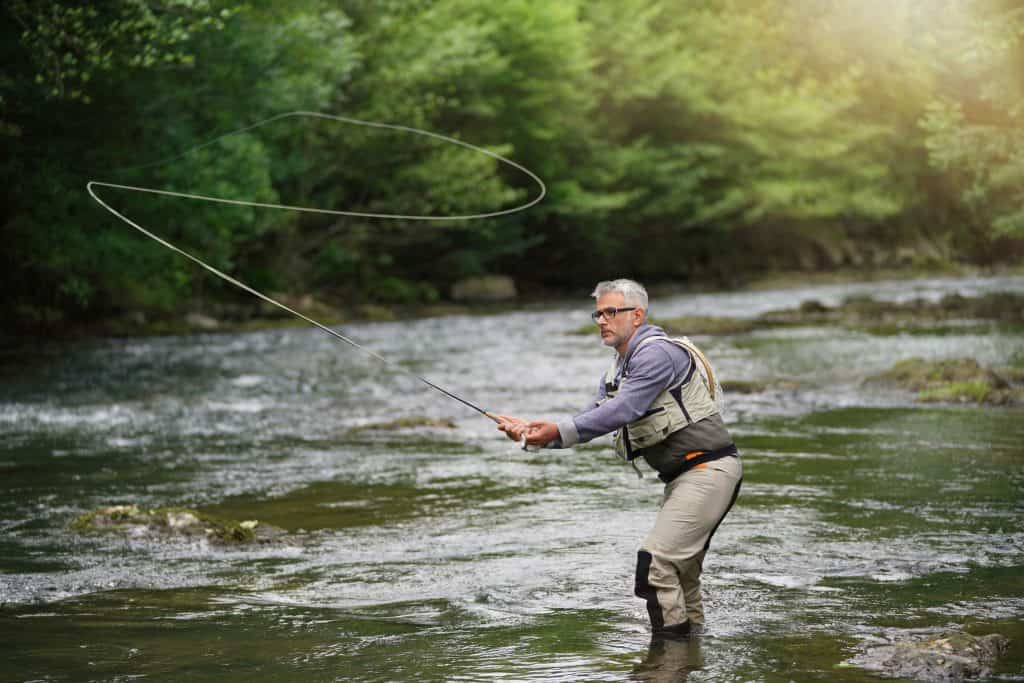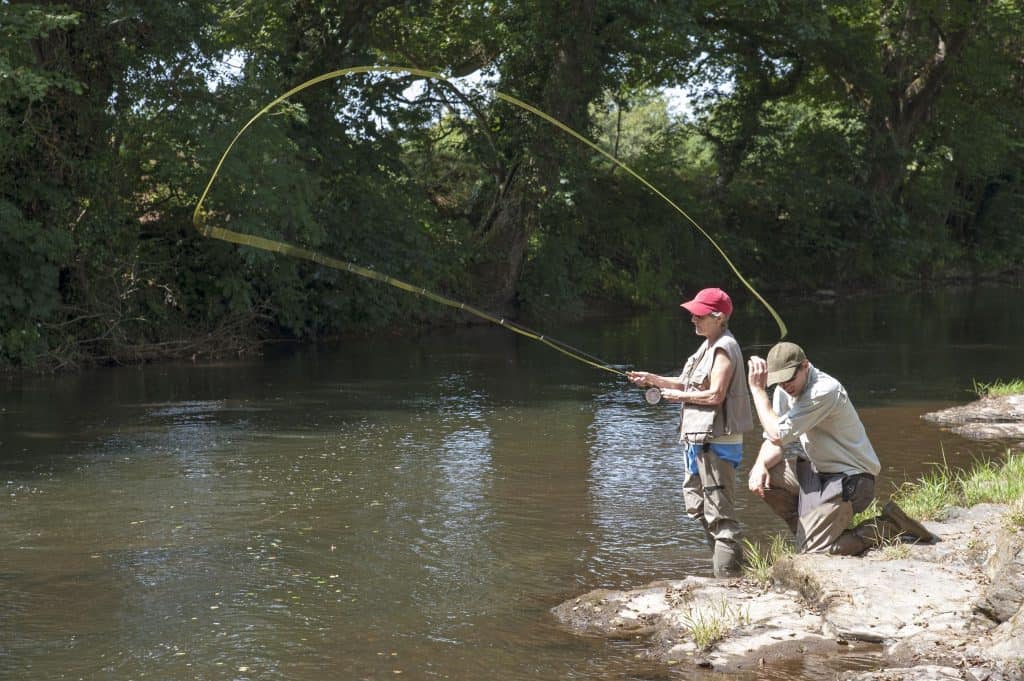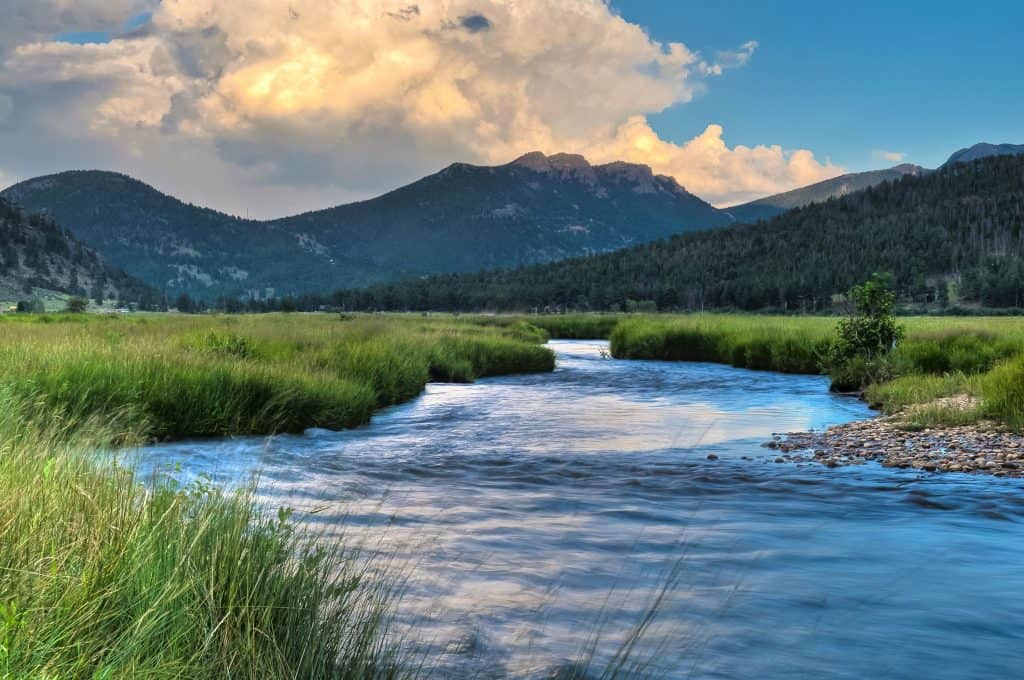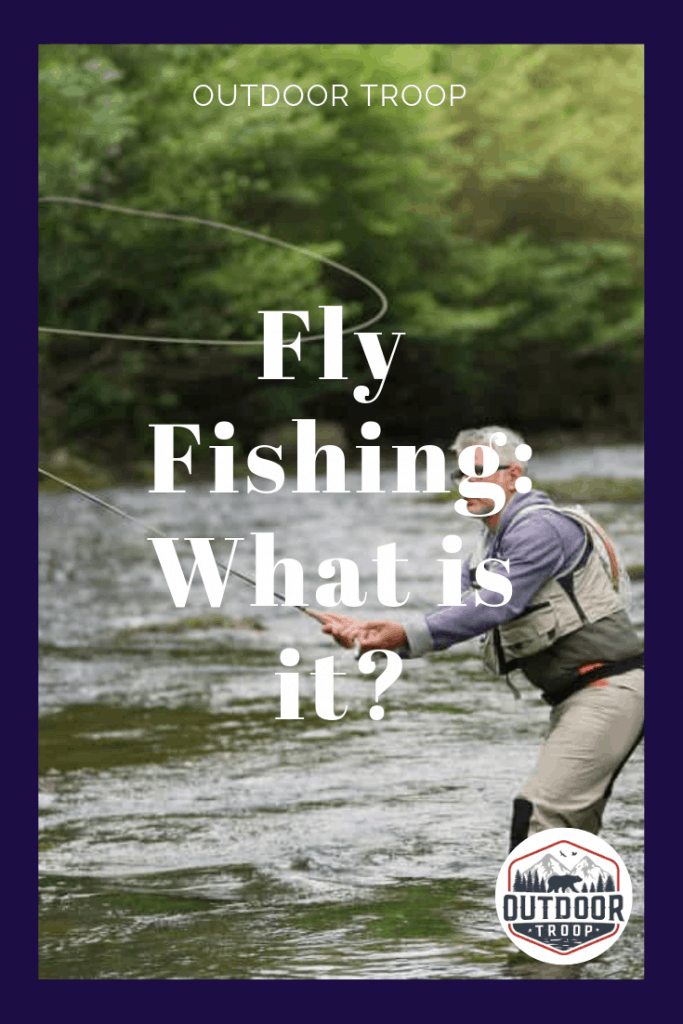
If you’re interested in fishing, you’ve probably heard of the technique called fly fishing. I was initially unfamiliar with this method since I mainly use live bait, so I decided to do some research to provide a solid explanation for what this technique involves.
What is fly fishing? Fly fishing is a method of fishing that requires a lightweight rod and artificial bait. This bait is created to mimic the natural prey of fish. Flies are crafted to imitate surface-dwelling or aquatic insects.
Fly fishing is a unique style of fishing, and it can take some time to get used to. There are a few important components to keep in mind if you want to become proficient at it, such as choosing the right flies, practicing proper casting techniques, and selecting good fishing locations.
What are Fishing Flies?
Fly fishing uses a different kind of bait than metallic spin lures or live bait. When you’re fly fishing, you’ll be using imitations of real insects to attract fish. The lures themselves are artificial bugs that are attached to fishing hooks.
By floating these on top of, or just beneath the surface of the water, the lure will mimic the appearance of a real insect. Because there are real insects that behave this way, the fish can be fooled by the imitation and go for the fake bait.
The key is all about how realistic the lure is and if it is the right kind of prey for your target fish. Since the fish won’t be able to smell the lure like they would for live bait, a greater amount of precision is necessary to catch their attention.
In other words, the lures have to look convincing and move realistically along the water to mimic the chosen insect.
Fly lures can come from multiple places. Many outdoor supply shops or even big name businesses such as Walmart and Amazon provide boxes of flies for fishermen. These amount of flies in these kits can range from a few specialized lures to packs containing hundreds!
Store-bought flies are often the easiest and cheapest way for new fishermen to get started. You don’t need a huge selection to begin, and most of the prices are reasonable for starter sets.
However, some of the more advanced fly fishers prefer to create their own flies. This isn’t necessary (or usually practical) for the beginner, but many fishermen have been able to craft unique and custom designed flies this way.
You may think that it’s cheaper to make your own flies instead of buying a set, but this usually isn’t the case. Crafting one’s own flies takes a lot of different materials, time, and practice.
Tying your own flies usually doesn’t become cost efficient until you have created hundreds of them, meaning that this activity is only worthwhile for those who are avid fishers with massive fly collections.
Of course, if you are interested in tying your own flies, this can be an enjoyable and immersive hobby to get into. But if you’re just an amateur fly fisher, it’ll cost you a lot less work and money to just stick with store-bought packs.
Wet vs. Dry Flies
Depending on the type of fish you want to attract and their main food source, you’ll want to consider the types of flies you’re using. Some fish mainly eat surface-dwelling insects, while others prefer aquatic insects, grubs, and smaller fish.
This is where the different specialization of wet versus dry lures comes into play.
Wet flies mimic prey that can be found beneath the surface of the water. These can include insect larvae, crayfish, or small prey fish. These lures are generally larger and heavier than dry flies and will sink deeper into the water.
Wet flies are generally easier for the beginning fly fishermen because there is more room for error. The weight of a wet fly makes it easier to cast, and the fish who go after underwater prey are generally less cautious and easier to fool with false bait.
On the other hand, dry flies imitate light, surface-dwelling insects such as stoneflies, water skippers, and mayflies. This technique is much more challenging to learn because fish who eat near the surface are much more cautious of frauds.
The lure must be cast lightly and precisely, so it looks just like an insect landing on the surface of the water. If it is the wrong type of fly or even the wrong time of day, fish will usually ignore the bait.
Dry fly fishing is a method that a lot of the more seasone fishermen enjoy. It’s more difficult to select the right flies, and there is less room for error. However, the challenge is what makes this exciting for many people!
So if you are just starting out, wet flies are an easier, more forgiving way to learn how to fly fish. Choosing the right fly is less important and the added weight makes it easier to direct. But if you’re interested in a challenge, dry fly fishing can provide a unique challenge for you to improve your skills.
Bear in mind the differen pros and cons of wet and dry flies as you choose which method is best for you.
Differences in Fishing Rods
If you’ve ever gone fishing with live bait or spin lures, you’ll need to recognize that fly fishing requires different equipment than you’ve been using.
There are essentially two main types of fishing rod. One is a casting rod, and one is a spinning rod.
To put it simply, spinning rods are thinner, more flexible rods that are usually preferable for fly fishing. The precisely weighted line will give you the length and accuracy that is necessary for casting flies correctly.
Spinning rods will bend dramatically under the pressure of a fish bite, but this flexibility keeps them from snapping under force.
Casting rods are usually preferable for more serious fishing and are more difficult to master. Pressure from a biting fish on these rods will usually cause the rod to bend upward instead of forward. Casting rods are helpful for experienced fishermen who want to pull in large fish, but the learning curve is far steeper than with spinning rods.
Many fly fishermen will prefer to use spinning rods due to their more lightweight, flexible nature. It takes skill and practice to learn to use either rod, but spinning rods are usually the better variety for fly fishing.
Another factor you’ll need to keep in mind when selecting a fly fishing rod is the length. Fly rods generally range in length between eight and nine feet. Each size is best-suited to a particular style.
Eight-foot rods are useful for shorter, more precise casts. Rods that are about eight and a half feet long are the most versatile style which is good for all different types of casting. Nine-foot rods are best for long distance casts and have the longest reach of all.
Casting Tips

If you’re interested in learning how to fly fish, it’s never been easier to get started. With the huge increase of online resources such as YouTube and question boards, there are multiple avenues for an amateur to begin honing their casting technique.
If you’re just looking for some tips to get started though, here are a few skills that will be useful to develop.
Understand How Your Rod Works
As mentioned above, fly fishing rods function differently than other equipment you may have used in the past. The weight of your flies is almost nothing, so the fishing line itself is weighted to give you leverage.
Learn the different parts and function of a fly fishing rod. The components may be arranged in a different setup than you’re used to handling, so be sure that you’re comfortable with where everything is.
Move Slowly and Deliberately
It can be tempting to get as many casts out as possible when you start off. This can cause you to act quickly and lose track of your foundational techniques. Be sure to take your time with every cast and let the line flow out to its proper length.
Don’t get frustrated if it takes time for your fly to get attention. Sometimes the fish are picky and it may take multiple different flies and attempts before you get a bite. Moving faster could alert the fish that something is off, so be careful and deliberate with each cast.
Fish in Slow Moving Water
If you start off fly fishing in an area with quick or difficult water flow, you won’t have the right amount of space or time to learn what you’re doing. Slow water lets you keep track of your lure, and give you the time to see the path of the water. Look at where the currents and slow pools are.
Fish like to congregate in different kinds of water, so experiment with different areas to see where they might be. Slow moving pools are a popular place for many types of surface-feeding fish.
Film Yourself
If you feel like something isn’t quite right with your casting, film yourself and watch it later. You’ll usually be able to tell if something isn’t quite right or if you’re moving rigidly during parts where flexibility is required.
Don’t be afraid to show recordings to others and ask for their advice either. Many experienced fly fishers will be able to spot where you need improvement and can provide help if you want it.
Practice Often
This should go without saying, but practice makes perfect. As you get out and work on your technique, you’ll be able to find out what works and what doesn’t. You’ll also begin to feel more comfortable and loose, which will help you cast more naturally.
Best Lures for Your Area
Picking the right flies can be a complicated process. there are a lot of factors you need to keep in mind, particularly if you want to try fishing with dry lures.
You’ll need to know what kind of fish you’re targeting, what their preferred food is, which insects are in season, what kinds of food are likely to be in the area, and what time of day it is.
This might all sound overwhelming at first, but don’t worry! You’ll be able to quickly pick up what the most common and popular flies are for your specific needs.
There are a few basic flies that are always likely to get some interest though. Some good starting lures to look into include:
- The Parachute Adams
- The Woolly Bugger
- The Elk Hair Caddis
- The Bunny Leech
- The Common Crayfish
- The Pheasant Tailed Nymph
- The Blue Wing Olive
- The Bead Head Caddis Nymph
- The San Juan Worm
- The Black Stonefly
These are some of the most commonly seen flies for many areas, and they’re trustworthy starters if you don’t know where to begin.
You’ll want to do a little specialized research for your area though. If you don’t get crayfish in your local rivers, the fish probably won’t go after a lure that resembles one.
One easy way to find out what’s around the local bodies of water is to flip over a few river rocks next time you go fishing. You should be able to find a collection of aquatic insects, larvae, eggs, and worms if you look long enough.
This technique will give you a quick cross-section of what the local fish might expect to see.
Beyond the basic though, you should do some research on the common insects in your area. You’ll also want to find out which ones are preferred fish food. If you can get the right species, right time of year, and right area, you’ll have a successful fly on your hands!
Best Areas to Target

Once you pick out your flies, get used to using a fly rod, and really want to get out there and start fishing, you might be at a loss for where to start looking.
Depending on whether you’re using wet flies or dry flies, you’ll want to focus on different areas. Before you begin fishing, take a few minutes to observe the flow of the water and different patterns that might exist. Fish might be jumping up for insects in certain areas, which will give you hints about where to focus.
Generally speaking, fish like to be in areas that are near moving water so they can get proper oxygen flow, but not areas with a current that is too fast. They also like to hide behind protective objects such as logs and boulders.
Many fish who sit and wait for their prey to drift by can be found in cold, slow-moving water. These areas help them to conserve their energy since they don’t have to constantly struggle against a high current. Fish in these slow areas are often good targets for dry flies.
If the river is more shallow and fast moving, you may want to cast wet lures. Fish will see these larger offerings and won’t be able to get a good look at them before they have to decide whether or not to bite at them.
It may be hard to see where the fish are, but targeting slow pockets of water that are near currents and large objects is usually a safe bet.
Popular Fly Fishing Destinations
If you’re interested in taking your fly fishing hobby outside of your local rivers, streams, and lakes, there are several popular locations for the enthusiast to visit!
You can have a good fishing experience at many places that are close to home, but here are five of the top fly fishing destinations.
- San Juan River, New Mexico
This is a popular place to fish for large trout of multiple varieties. Rainbow, brown, and rainbow-cutthroat trout can all be found along this river.
2. Bighorn River, Montana
This is one of the most popular fly fishing destinations in North America due to the rich and productive waters that are perfect breeding grounds for many insects. Large trout are also common in this river.
3. Alagnak River, Alaska
This is an amazing fishing destination with chances to catch trout, grayling, and multiple species of salmon. The local wildlife is also diverse and largely preserved, making for a great outdoor expedition.
4. Colorado River Headwaters, Colorado
Rainbow, brook, brown, and cutthroat trout are abundant in a private 10-mile stretch of protected water. Catch and release with barbless hooks is the practice in this area, but it still provides a great experience.
5. “Blue Ribbon” Trout Streams, Idaho/Wyoming/Colorado
This area includes a network of fish-heavy streams and rivers that are all within 80 minutes of one another. Each is full of healthy populations of fish and seasonal swarms of insects.
Related Questions
Does fly fishing use hooks? Fly fishing is a method that uses lures attached to hooks. The two main options are barbless (which are smaller and harder for fish to see) and barbed (which are larger but more efficient at retaining a catch).
What do you catch with fly fishing? There are many different types of fish that can be caught with fly lures, but some of the most common varieties are trout, grayling, salmon, pike, and bass. Both freshwater and saltwater species can be caught using flies.

